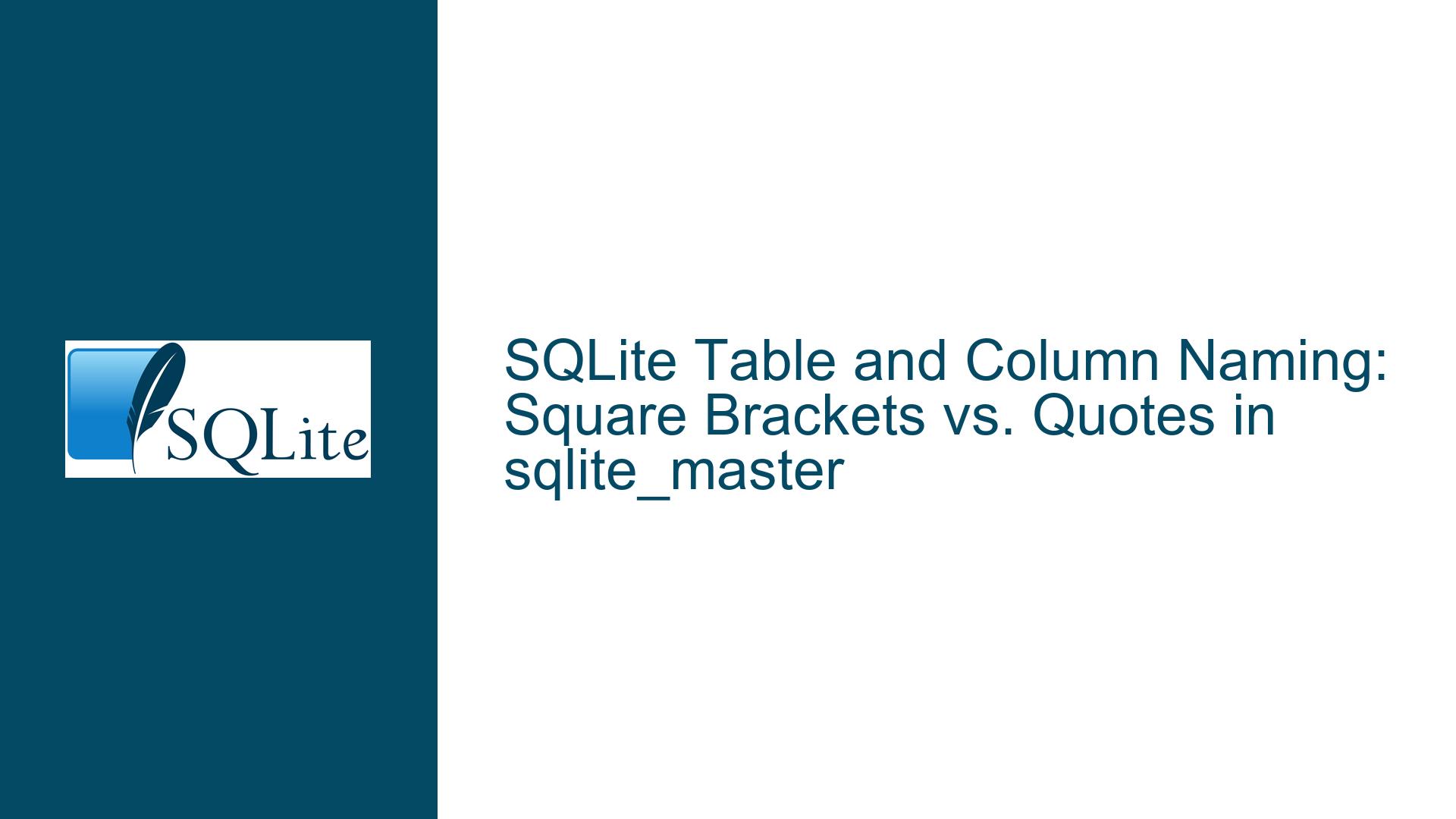SQLite Table and Column Naming: Square Brackets vs. Quotes in sqlite_master
Understanding Square Brackets and Quotes in sqlite_master’s SQL Column
The sqlite_master table in SQLite is a system table that stores the schema of the database. It contains a column named sql, which holds the SQL statement used to create the corresponding table, index, view, or trigger. Typically, the sql column displays table and column names inside square brackets ([]). However, there are instances where table or column names appear inside quotation marks ("). This behavior can be puzzling, especially when the names in question are not SQLite keywords or do not contain special characters.
The presence of square brackets or quotes in the sql column is not arbitrary. It is influenced by how the table or column was created or modified. Square brackets are generally used to enclose identifiers that are not keywords and do not require special handling. On the other hand, quotation marks are often used when identifiers are modified using certain SQL commands, such as ALTER TABLE, or when the database tool or application generating the SQL statement opts for a more conservative approach to naming.
Understanding why and when SQLite uses square brackets or quotes in the sql column requires a deeper dive into SQLite’s handling of identifiers, the impact of schema modifications, and the behavior of third-party tools that interact with SQLite databases.
The Role of ALTER TABLE and Third-Party Tools in Identifier Formatting
One of the primary reasons for the appearance of quotation marks in the sql column is the use of the ALTER TABLE command. When a table or column is renamed using ALTER TABLE, SQLite updates the sql column to reflect the new name. However, instead of using square brackets, SQLite encloses the new name in quotation marks. This behavior occurs regardless of whether the new name is a simple identifier or a complex one. The rationale behind this is to ensure that the new name is treated as a literal string, avoiding any potential conflicts or misinterpretations during subsequent operations.
For example, consider a table named Employees that is renamed to Staff using the following command:
ALTER TABLE Employees RENAME TO Staff;
After this operation, the sql column in the sqlite_master table will display the table name Staff inside quotation marks:
CREATE TABLE "Staff" (...);
This behavior is consistent even if the new name does not contain special characters or is not a keyword. It is a safeguard to prevent issues that might arise from ambiguous or reserved identifiers.
Another factor that influences the formatting of identifiers in the sql column is the use of third-party tools. Tools like SQLite Export Pro may generate SQL statements that use quotation marks instead of square brackets. This is often done to ensure compatibility across different SQL environments or to adhere to stricter naming conventions. When such tools modify the database schema, the resulting SQL statements in the sql column may reflect the tool’s preferred formatting style.
For instance, if SQLite Export Pro adds a new column to a table, it might generate an ALTER TABLE statement that encloses the new column name in quotation marks:
ALTER TABLE Staff ADD COLUMN "DepartmentID" INTEGER;
As a result, the sql column will show the new column name inside quotation marks, even though the name itself is straightforward and does not require special handling.
Best Practices for Managing Identifier Formatting in SQLite
To maintain consistency and avoid confusion in the sql column, it is important to follow best practices when naming tables and columns and when modifying the database schema. Here are some recommendations:
Use Consistent Naming Conventions: Stick to a consistent naming convention for tables and columns. Avoid using reserved keywords or special characters in identifiers. This reduces the likelihood of needing special formatting in the
sqlcolumn.Minimize the Use of ALTER TABLE: While
ALTER TABLEis a powerful command, frequent use can lead to inconsistencies in thesqlcolumn. Whenever possible, plan your schema changes in advance to minimize the need for renaming tables or columns.Be Mindful of Third-Party Tools: When using third-party tools to manage your SQLite database, be aware of how they generate SQL statements. Some tools may introduce formatting that differs from SQLite’s default behavior. If consistency in the
sqlcolumn is important, choose tools that align with your preferred naming conventions.Inspect the sqlite_master Table Regularly: Periodically review the
sqlite_mastertable to ensure that thesqlcolumn reflects the expected formatting. This can help you identify any inconsistencies or unexpected changes introduced by schema modifications or third-party tools.Use PRAGMA Statements for Advanced Control: SQLite provides several PRAGMA statements that allow you to control aspects of the database’s behavior. For example, the
PRAGMA legacy_alter_tablesetting can influence howALTER TABLEcommands are processed. Familiarize yourself with these PRAGMA statements to gain finer control over schema modifications.
By following these best practices, you can ensure that the sql column in the sqlite_master table remains consistent and predictable, making it easier to manage and troubleshoot your SQLite database.
Troubleshooting Inconsistent Identifier Formatting in sqlite_master
If you encounter inconsistencies in the sql column of the sqlite_master table, there are several steps you can take to diagnose and resolve the issue:
Review Recent Schema Changes: Start by reviewing any recent changes to the database schema. Look for
ALTER TABLEcommands or modifications made by third-party tools. These changes are often the source of inconsistencies in thesqlcolumn.Check for Reserved Keywords: Verify that none of the table or column names are SQLite reserved keywords. Even if a name is not currently causing issues, using a reserved keyword can lead to unexpected behavior in the future. If you find any reserved keywords, consider renaming the affected tables or columns.
Examine Third-Party Tool Settings: If you are using third-party tools to manage your SQLite database, review their settings and documentation. Some tools allow you to customize how SQL statements are generated. Adjusting these settings can help align the tool’s output with your preferred naming conventions.
Recreate the Schema: In cases where the
sqlcolumn contains significant inconsistencies, consider recreating the database schema from scratch. Export the data, create a new database with the desired schema, and import the data into the new database. This approach ensures that thesqlcolumn reflects the correct formatting.Use SQLite’s Built-in Functions: SQLite provides built-in functions that can help you manipulate and inspect identifiers. For example, the
quote()function can be used to safely enclose identifiers in quotes, while theunquote()function removes them. These functions can be useful when generating SQL statements programmatically.Consult SQLite Documentation: SQLite’s official documentation is a valuable resource for understanding how identifiers are handled and formatted. The documentation provides detailed information on the behavior of
ALTER TABLE, thesqlite_mastertable, and other relevant topics.
By systematically addressing the factors that contribute to inconsistent identifier formatting, you can maintain a clean and predictable sql column in the sqlite_master table. This, in turn, simplifies database management and troubleshooting, ensuring that your SQLite database remains robust and reliable.
Conclusion
The presence of square brackets or quotation marks in the sql column of the sqlite_master table is influenced by a combination of SQLite’s internal behavior, schema modifications, and the use of third-party tools. Understanding the reasons behind these formatting choices is key to maintaining a consistent and manageable database schema. By following best practices and employing effective troubleshooting techniques, you can ensure that your SQLite database remains well-organized and free from unexpected inconsistencies. Whether you are a seasoned database developer or new to SQLite, paying attention to these details will enhance your ability to work with this powerful and versatile database engine.






